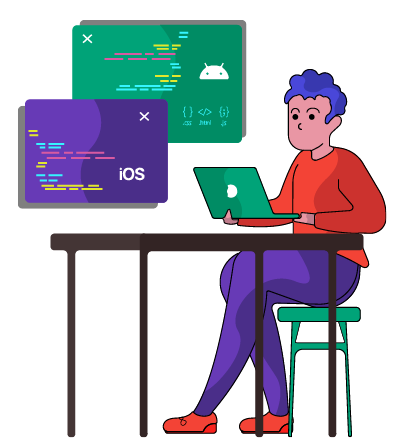Mobile app development has come a long way since its inception, with different approaches and technologies being used to cater to the growing demands of users and businesses alike. Two of the most popular methods of developing mobile apps are web/HTML5 apps and native apps. In this article, we will dive deep into these two approaches, discussing their advantages, limitations, and the future of mobile app development.
Web/HTML5 Apps
Web/HTML5 apps are essentially web applications optimized for mobile devices. They are built using standard web technologies such as HTML5, CSS, and JavaScript, and can be accessed through any modern web browser. These apps can provide a cost-effective solution for businesses that want to reach a broad audience without investing heavily in platform-specific development.
Advantages:
Cross-platform compatibility: Web/HTML5 apps can run on any device with a modern web browser, making it easier to develop and maintain a single codebase for multiple platforms.
Reduced development time and cost: Developing a web/HTML5 app typically requires less time and resources compared to native app development, as there is no need to write separate code for each platform.
Easier updates: Since web/HTML5 apps are hosted on a server, updates can be rolled out quickly and seamlessly, without the need for users to download and install updates manually.
Limitations:
Performance: Web/HTML5 apps generally have slower performance compared to native apps, as they rely on web technologies and cannot leverage the full potential of the device's hardware.
Limited access to device features and APIs: Web/HTML5 apps have restricted access to device-specific features and APIs, which can limit the functionality and user experience of the app.
Offline functionality: Although some offline capabilities can be implemented in web/HTML5 apps, they are usually limited in comparison to native apps.
At present there are several browsers, which have small differences, which means that certain features used in the development of Web/HTML5 applications do not work in the same way, which requires that the tests must include at least the most popular ones, but without neglecting the less popular ones.
For a Web/HTML5 application to be used in a mobile environment, it has to be developed with responsiveness in mind.
Native Apps
Native apps are developed specifically for a particular platform, such as Android or iOS, using platform-specific languages like Java, Kotlin, or Swift. These apps can harness the full potential of the device's hardware and features, resulting in better performance and a more seamless user experience.
Advantages:
Performance and efficiency: Native apps can access the full range of device features and APIs, leading to better performance, responsiveness, and user experience.
User experience and platform-specific UI design: Native apps can adhere to platform-specific design guidelines, ensuring a consistent and intuitive user experience across devices.
Access to the latest platform features and APIs: Native app developers can quickly implement new features and APIs released by platform owners, ensuring that their apps stay up-to-date with the latest advancements in mobile technology.
An app developed in the native language, it fits perfectly to various mobile devices without having to do any additional programming for it, and it worked perfectly in offline environments.
Limitations:
Higher development time and cost: Developing native apps for multiple platforms requires separate codebases, leading to increased development time and costs.
Platform-specific expertise: Native app development requires developers to have expertise in platform-specific languages and tools, making it more challenging for businesses to find and retain skilled developers.
The Future of Mobile App Development: MCSS and Native Apps
With the continuous evolution of mobile technology and increasing user expectations, native apps are becoming the preferred choice for delivering high-quality, user-centric experiences. MCSS (Mobile Cascade Style Sheet) is a revolutionary framework that bridges the gap between native and cross-platform development, making it easier to develop 100% native apps for both Android and iOS.
MCSS simplifies native development by allowing developers to work with both Java, Kotlin, and Swift simultaneously, significantly reducing development time and costs. It also minimizes the learning curve for developers familiar with CSS, making native development more accessible to a broader range of developers.
As businesses increasingly recognize the importance of providing seamless, high-quality user experiences, native app development with MCSS is poised to become the future of mobile app development.
In addition to the performance and user experience benefits of native apps, MCSS offers several advantages that make it an attractive option for developers:
Increased efficiency and effectiveness: With simultaneous support for Android and iOS, MCSS enables developers to create native apps with increased efficiency, reducing time-to-market and ensuring a consistent user experience across platforms.
Making native development more accessible: MCSS's similarity to traditional CSS means that developers with web development experience can easily transition to native app development. This opens up new opportunities for businesses to tap into a wider pool of talent, ultimately leading to better apps and happier users.
Support for continuous evolution of mobile platforms: MCSS allows developers to stay up-to-date with the latest platform updates, new features, and deprecated APIs, ensuring that their apps remain compatible and feature-rich as mobile technologies continue to evolve.
Enhancing user experience through fully native apps: By leveraging MCSS, developers can deliver fully native apps that offer a seamless, high-quality user experience, ultimately leading to higher user satisfaction, better app adoption, and increased revenue opportunities for businesses.
Conclusion
In conclusion, the future of mobile app development lies in native apps. With the emergence of technologies like MCSS, native app development is becoming more accessible, efficient, and cost-effective, allowing businesses to deliver high-quality, user-centric apps that cater to the ever-evolving demands of mobile users.
As the mobile landscape continues to evolve, businesses must carefully consider their app development approach and long-term goals. By embracing MCSS and native app development, businesses can ensure that they remain at the forefront of mobile technology, delivering exceptional user experiences and staying ahead of their competition in the rapidly changing world of mobile apps.

